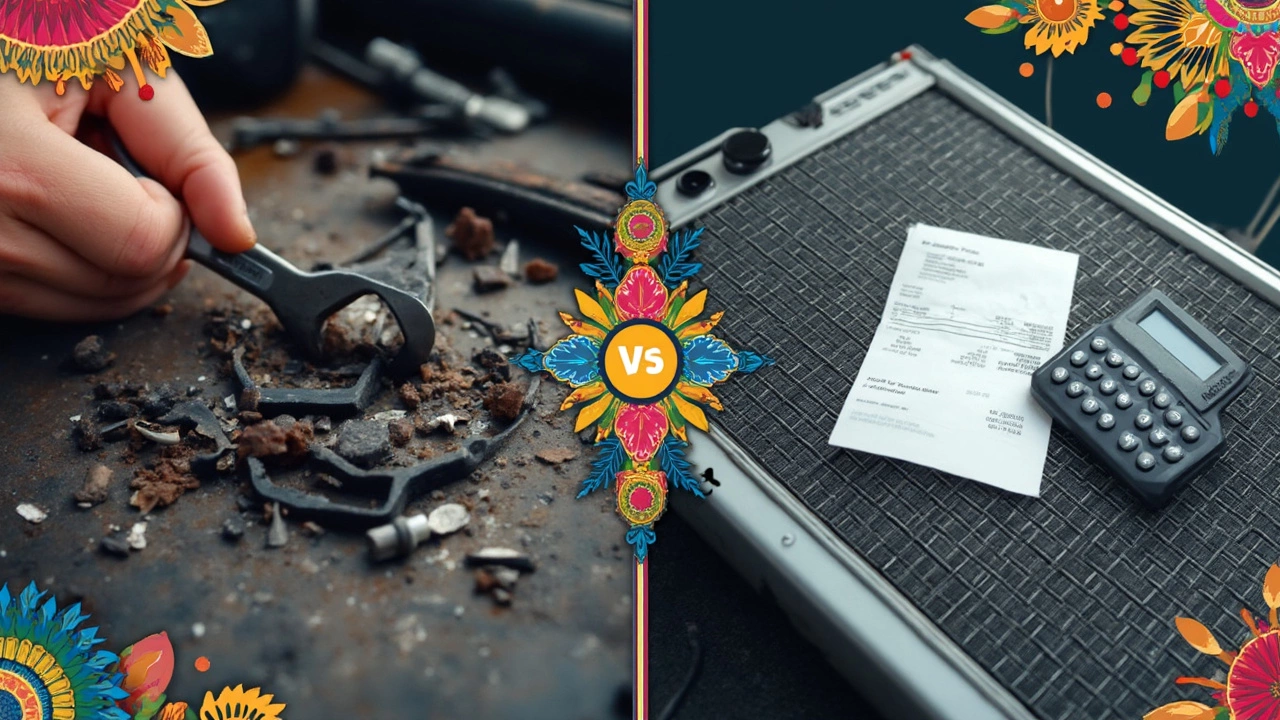Is It Cheaper to Replace or Repair a Radiator?
 Feb, 7 2025
Feb, 7 2025
Car radiators are a bit like our own circulatory system, crucial for keeping things cool under pressure. When they start acting up, it can be a real headache. So, do you fix it or toss it out for a new one? This is a question many of us ponder when faced with a smoking engine or a telltale puddle under the car.
Before you even think about the cost, it’s good to know what your radiator actually does. It’s not just about keeping the engine cool. It’s a part of a bigger system that ensures your car doesn’t overheat, which can lead to major engine problems. But when it comes to figuring out whether it's cheaper to repair or replace, the answer isn't always clear-cut.
Repairs might seem cheaper at first glance, especially if it's just a minor leak or a clogged pipe. But if the radiator is old or severely damaged, replacement could actually save you money down the road. It's important to consider both options carefully, looking at the long-term effects and costs. Still, understanding the specific problem and knowing what you're dealing with is key to making a smart decision.
- Understanding Radiator Roles and Signs of Trouble
- Cost Breakdown: Repair vs. Replacement
- Factors Affecting Your Decision
- DIY vs. Professional Services
- Tips for Radiator Maintenance
Understanding Radiator Roles and Signs of Trouble
Your car's radiator plays a vital role in regulating the temperature of the engine. Think of it as the lungs of your vehicle's cooling system. It helps dissipate the heat generated by the engine, keeping your ride smooth and preventing meltdowns on the road.
How Does a Radiator Work?
The process begins with the radiator circulating coolant through the engine block. This coolant absorbs the heat from the engine and heads back to the radiator. There, it gets cooled by air flowing through the radiator fins. This cycle keeps the engine at a stable temperature, which is crucial for optimal performance.
Signs Your Radiator Might Be in Trouble
Ignoring radiator issues can lead to serious car troubles, so it's best to catch them early. Here are some signs that you should get your radiator checked:
- Overheating: This is the most obvious sign. If your engine's temperature gauge climbs higher than usual, your radiator might be struggling.
- Coolant Leaks: Puddles under your car can mean a leak. Check for bright green, orange, or pink fluid, as these are common coolant colors.
- Discolored or Sludgy Coolant: If the coolant inside the radiator looks rusty or sludge-like, it's not doing its job properly and can cause clogs.
- Frequent Need for Coolant Top-Ups: Constantly needing to refill your coolant might mean there's a leak somewhere.
- White Steam from the Hood: This often indicates an overheating engine, which could be due to radiator failure.
Common Radiator Issues
Sometimes it can be a simple fix, but other times your radiator might need more attention:
- Leaks: These can occur in hoses, the radiator itself, or connections due to wear and tear.
- Rust Development: Over time, metal parts of the radiator can corrode, leading to rust blocking the flow of coolant.
- Clogging: Old or dirty coolant can lead to deposits inside the radiator, causing blockages.
Spotting these issues early can save a lot of headaches. Regular maintenance and checks for your car radiator are crucial for keeping everything in optimal shape.
Cost Breakdown: Repair vs. Replacement
When it comes down to dollars and cents, car radiator repair and replacement can vary wildly in cost. It’s not just about the immediate expense, but the potential long-term implications too.
Repair Costs
If your radiator needs a basic fix, like patching up a minor leak or flushing out a clog, you're looking at spending anywhere from $100 to $300. These repairs are usually quick, and if caught early, they can extend the lifespan of your car radiator without breaking the bank. However, it’s crucial to assess if the repair will genuinely solve the problem or if it’s just a temporary band-aid.
Replacement Costs
On the flip side, installing a new radiator generally costs between $300 and $1200, depending on your car’s make and model. Higher-end vehicles or those with specialized radiators will sit on the pricier end of that spectrum. The big advantage here is that a new radiator means a fresh start, often coming with a warranty that protects your investment.
Comparative Table
| Option | Cost | Pros | Cons |
|---|---|---|---|
| Repair | $100 - $300 | Low cost, Quick | May not solve severe issues |
| Replacement | $300 - $1200 | Long-term solution, Warranty | Higher cost |
Budget Considerations
The decision often boils down to your budget and the radiator’s current condition. A patch might seem cheaper now, but if your radiator is nearing the end of its life, a replacement might be more economical in the long run.
A useful tip: regularly inspecting your radiator could save you from costly work. Early detection of issues means you might catch those minor repairs before they spiral into something more serious.
Additional Factors
Remember, labor costs also play into this equation. Repair jobs might not take long, keeping labor fees lower. In contrast, a new radiator installation could take more time, meaning higher labor costs. And of course, DIY solutions can cut these fees down, but be sure you know what you're doing, as mistakes could end up costly.

Factors Affecting Your Decision
When you're stuck between fixing or swapping out that picky car radiator, it helps to know what might sway your choice. Several things can steer you one way or the other, from budget constraints to how long you plan on keeping the car. Let's break it down a bit further.
Budget Considerations
Your wallet will often have the final say in these matters. If the repair costs less than half the price of a new radiator, repairing it could be the way to go. However, if it's creeping up close to full replacement cost, think twice. A newly installed car radiator might give you longer peace of mind.
Age and Condition of the Car
The age of your ride plays a big role. Older cars, especially those nearing their last legs, might not justify a full replacement. Are you planning to drive your car for a good few more years or sell it soon? If you’re keeping it, investing in a new radiator might offer reliability; if not, you might just opt for a quick fix.
Frequency of Problems
How often are you visiting the mechanic? If you're seeing recurring issues with leaks or frequent overheating, replacement could save time and prevent further headaches. A sturdy new radiator can be less hassle in the long run.
DIY vs. Professional Costs
Are you handy with a wrench? If you're looking to save some cash and the fix is something you can tackle on a Saturday afternoon, it might be worth giving it a shot. On the flip side, if the problem's complex or you’re not confident, hiring a pro can be worth the investment. Sometimes, paying for expertise prevents bigger issues down the road.
| Option | Pros | Cons |
|---|---|---|
| Repair | Less immediate cost, Quick fix | May not last long, Recurring cost risk |
| Replace | Long-term solution, Warranty benefits | Higher initial cost, Requires more downtime |
DIY vs. Professional Services
Tackling a car radiator issue comes with the big question: should you go DIY or call in the pros? There's a lot to consider here and both paths have their own perks and pitfalls.
Going the DIY Route
If you're someone who enjoys rolling up their sleeves, DIY radiator repair might seem like an appealing option. Not only can it save you some cash, but it also gives you a hands-on understanding of your car’s innards. Basic fixes like patching up a small leak or flushing out the system could be manageable for the weekend warrior.
Here’s a quick checklist for DIY repair:
- Identify the problem: Is it a leak, blockage, or maybe just a dirty radiator?
- Have the right tools: Wrenches, screwdrivers, pliers, and a car jack are essentials.
- Research thoroughly: Many tutorials and manuals are available online.
- Take safety precautions: Always ensure the car is cooled down before you start.
That said, it’s important to know your limits. Missteps can lead to larger issues and end up costing more than if a professional handled it from the get-go.
Trusting the Professionals
Opting for professional radiator repair services can spare you the hassle and ensure the job is done right. Mechanics have the expertise and diagnostics tools that the average DIY enthusiast might not have access to.
Here's what you can expect from professional services:
- A thorough diagnostic check to spot all potential issues.
- Access to quality replacement parts that come with a warranty.
- Usually faster turnaround, saving you time.
Professionals can also spot underlying issues that aren’t immediately visible. While this might cost more upfront, it can save you from expensive long-term damage.
If you are curious about costs, here's a general breakdown from recent data:
| Service Type | Average Cost (USD) |
|---|---|
| DIY Parts and Tools | 50 - 150 |
| Professional Repair | 300 - 800 |
In the end, the decision between DIY and professional services depends on your confidence, skill level, and the complexity of the radiator issue. Whether you choose to roll up your sleeves or hand over the car keys, what's most important is ensuring your car’s radiator is in top shape for the long drives ahead.

Tips for Radiator Maintenance
Regular maintenance of your car's radiator can save you a lot of trouble and money down the road. A well-maintained radiator ensures your engine operates smoothly and efficiently. Here are some crucial tips to keep your car radiator in top shape.
Keep an Eye on Coolant Levels
Coolant is the lifeblood of the radiator system. Check your coolant levels regularly and top up as needed. Make sure you use the correct type of coolant for your vehicle, as mixing different types can cause blockages.
Flush the Radiator
Flushing the radiator is something you should look at doing once a year or according to your car's specifications. It clears out sediment or rust buildup that can hinder the radiator's performance.
Inspect for Leaks
Leaks are a common problem in radiators. Regularly inspect for any visible signs of leaks such as puddles beneath the car or low coolant levels. Catching these early can prevent more severe damage and costly radiator repair.
Check the Radiator Cap
It's often overlooked, but the radiator cap plays an important role in maintaining pressure within the system. A faulty cap can lead to overheating, so make sure it's in good condition.
Keep the External Clean
The outside of the radiator can get clogged with debris, hindering airflow. Using a hose, gently wash away any dirt or leaves stuck to the fins.
- Inspect hoses: Damaged or cracked hoses should be replaced promptly to avoid leaks.
- Use additives: Consider using radiator additives to prevent rust and lubricate the system.
By following these easy tips, you're not just saving money on potential radiator replacement, but also ensuring your car runs cooler and lasts longer. Consistency is key, so make these checks a regular part of your car maintenance routine!